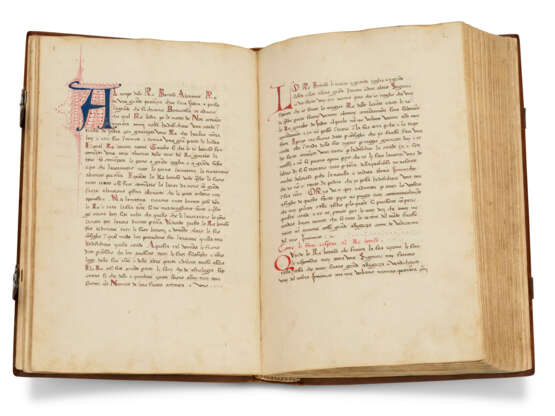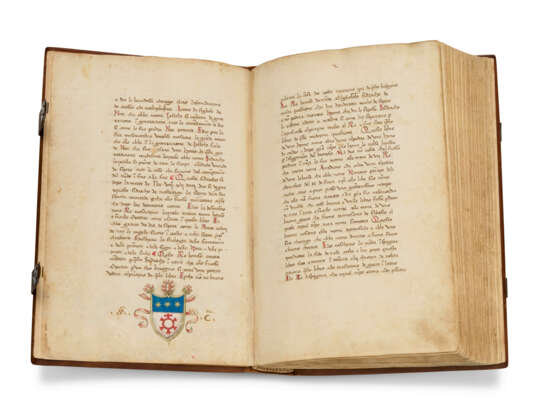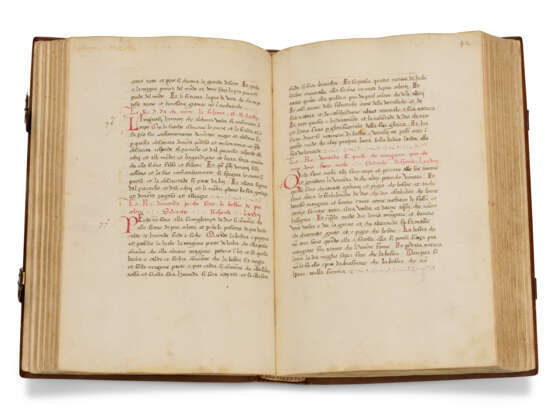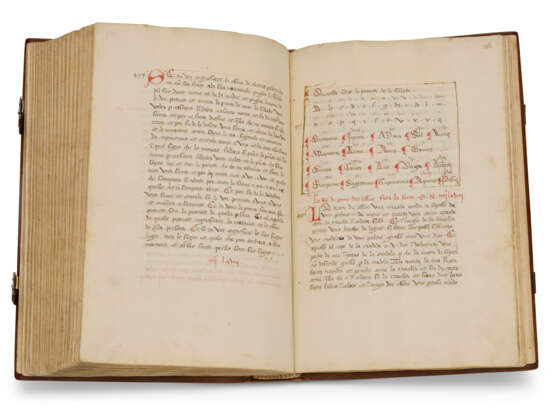ID 1449848
Лот 17 | A medieval scientific encyclopedia
Оценочная стоимость
£ 40 000 – 50 000
Il Libro di Sidracho, in Italian, decorated manuscript on paper [Verona, 2nd half 15th century]
How big is the world? Why is the sun hot? Where does wind come from? Why is the sea salty? How many stars are in the sky? A veritable encyclopedia of medieval scientific knowledge and culture: the Book of Sydrac, from the collections of Sir Thomas Phillipps, in its rare Italian translation.
340 x 220mm. 196 leaves, collation: 1-1810, 199(of 10, lacking x), 207(of 10, viii-x cancelled blanks), contemporary foliation 1-18 for the index and 1-180 for the main body of the text, 26 lines, ruled space: 190 x 140mm, horizontal catchwords survive, rubrics in red, capitals stroked in red, two-line initials in red throughout, two large initials: in red with purple penwork flourishing and in blue with red penwork flourishing, coat of arms with the initials Mco Cno in the lower margin of f.1 recto and verso (lacking f.173, else complete, some marginal thumbing, spotting and occasional dampstaining but generally in very good condition). Bound in modern tanned calf over beveled wooden boards preserving substantial portions of the original blind-tooled Italian leather, six brass bosses on upper cover, five on lower cover, brass catches and clasps.
Provenance:
(1) The paper bears watermarks similar to Briquet 11736-11740 (Verona, 1444 and 1463) and 12135 (Verona, 1491-1502). The coat of arms on f.1 recto-verso with the initials M[ar?c]o C.no is argent a ?cog with cross gules, above a chief azur charged with three stars or. The arms do not seem to appear in Rietstap or in the Blasonario delle Famiglie Subalpine.
(2) Richard Heber (1773-1833): his sale by Evans, Bibliotheca Heberiana, Catalogue of the library of the late Richard Heber, Esq. Part the eleventh. Manuscripts, 10 February 1836, lot 1520.
(3) Sir Thomas Phillipps (1792-1872), English antiquary and book collector who amassed the largest collection of medieval manuscript material in the 19th century: his MS. 8352; his sale, Sotheby's, 29 November 1966, lot 74.
(4) H. P. Kraus. New York, Catalogue 186: Science including Medicine and the Occult, 1991, no 146.
(5) J. R. Ritman: his Bibliotheca Philosophia Hermetica ex-libris on inside upper cover.
Content: Il Libro di Sidracho, ff.1-196 [1-18 and 1v-180v]: prologue, beginning: 'La providiencia de dio padre che puo tute le cosse', ff.1-3; table of contents with brief summaries of each chapter ff.3-18; the text proper beginning on f.18v, the foliation here beginning again at 1v: 'Al tempo dello Re Botuso a levante, Re de una grande provincia chi e intra India e Persia la grande che si chiama Botuensia', ending on f.180v: 'Sidracho a monsta et che lo adoperiamo al honore del corpo et al prode de lanima, Amen'.
An encyclopedia of medieval science, the Book of Sydrac (here 'Sidracho') is known by several titles and is represented by over seventy manuscripts, with translations into numerous vernaculars, including French, Italian, Provencal, Catalan, English, Flemish and German. The origins of the work are obscure, but its earliest incarnation seems to be in French by an unknown author writing in the final quarter of the 13th century. At once scientific encyclopedia, almanac, romance and melting pot of medieval popular culture covering everything from philosophy to astrology, religion, obstetrics, geography, mineralogy, medicine and natural science, it was particularly popular among aristocratic patrons and can be found in some of the most important Renaissance libraries.
The prologue relates that Sydrac, a descendant of Japhet and astronomer to King Tractabar, inherited a book of divine revelation of all mysteries and sciences, which had been dictated to Noah by an angel. He passed on his knowledge to King Boctus ('Botuso' in Italian), who had been engaged in a fruitless and frustrating war with his neighbour King Gharab of India ('Garambo' here in Italian), and Boctus had his own questions and the prophet's answers recorded in a book: each chapter heading in our manuscript is preceded by the words 'Lo Re d[omanda]', followed by the king's question, and then 'S[idracho] R[isponde]'. The story goes that the book passed into Spain, then to Tunis, then to the court of Frederick II at Palermo, and then back to Toledo in Spain ('Toiletta' here in the Italian), brought there by a clerk called Oberto Piero di Bone. Internal evidence suggests that the book may indeed be derived from the mixture of Latin and Arabic culture which flourished in Sicily under the Norman and Hohenstaufen kings: it draws from Gautier de Metz's Image du monde, the Philosophia mundi of William of Conches and, among other things, the Introductorium in astronomiam by Albumasar. The dialectic between Boctus and Sydrac begins here on f.12 of the main text, and contains 578 questions and answers. The number of questions varies from redaction to redaction, with 'short' versions (usually found in earlier manuscripts) typically containing around 600 questions, and 'long' versions well over 1,000. The questions cover the whole gamut of medieval scientific and popular concerns, from what happens to blood when the body dies ('que advene del sangue quando lo corpo e morto', f.24), the size of the world ('quanto e longo lo mondo e largo e spesso', f.55), to where thunder and lightning comes from ('da que viene le tuoni et li lampi', f.56), why the sun is hot and the moon cold ('perche e lo sole caldo e la luna freda', f.66v); where you can find precious stones ('di quante maniere [...] sono le pietre preciose et dove si trovano', f.161v), and how the sun, moon and stars are suspended in the sky ('Come se tengono in ciello lo sole e le stelle e la luna', f.82).
The Italian translation first appears early in the 14th century, and the first printed Italian edition appears in 1868, based on the late-14th -century copy in Florence (see A. Bartoli, Libro di Sidrach, testo inedito del secolo XIV, 1868). Most of the extant manuscripts are in institutional ownership. De Ricci records only one manuscript of the text in Italian in the United States.
| Место происхождения: | Италия, Европа |
|---|---|
| Категория аукционного дома: | Манускрипты Средневековья и Ренессанса, Книги и рукописи |
| Место происхождения: | Италия, Европа |
|---|---|
| Категория аукционного дома: | Манускрипты Средневековья и Ренессанса, Книги и рукописи |
| Адрес торгов |
CHRISTIE'S 8 King Street, St. James's SW1Y 6QT London Великобритания | |
|---|---|---|
| Предосмотр |
| |
| Телефон | +44 (0)20 7839 9060 | |
| Комиссия | see on Website | |
| Условия использования | Условия использования |







